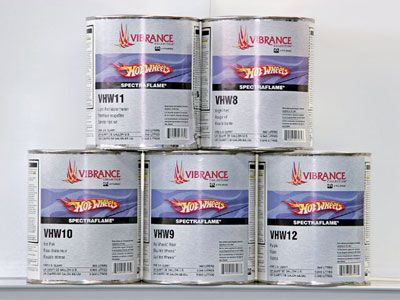
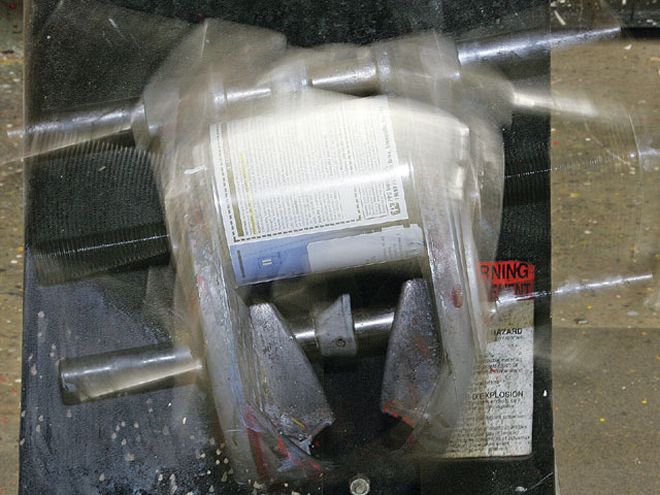
Like all facets of the automotive hobby, exterior finish technology and trends are continually changing. A few professionals shared their opinions on this topic in the article "It Ain't Just Paint" (HPP, Mar. '07). We learned then which products best replicate a vintage sheen, those that yield the most visually-appealing finish, and some of the legal hurdles hobbyists face when attempting to perform home restorations.
While compiling information for that article, one of the professionals we spoke with, Ron Stazzoni of D&R Auto Paint and Supply in Omaha, Nebraska, commented about the various types of paint available today, the high number of specialty colors that are popular with hobbyists, and some looming technology that he feels will eventually affect all hobbyists-but not necessarily in a negative fashion. Follow along as he shares his opinion on the current trends and future of automotive exterior finishes
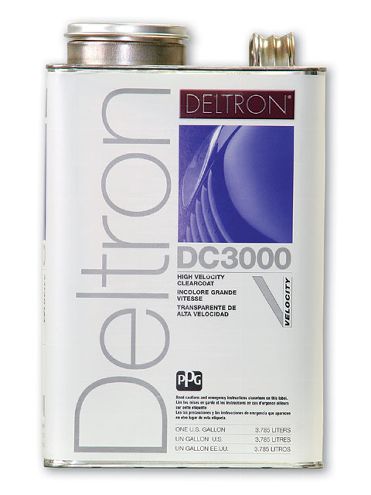 PPG's Deltron line contains a full line of easy-to-use professional-series products that are quite popular with collision repair shops. The wide range of color availability makes it a popular choice of restoration professionals and street rod builders.
PPG's Deltron line contains a full line of easy-to-use professional-series products that are quite popular with collision repair shops. The wide range of color availability makes it a popular choice of restoration professionals and street rod builders.
Today's Trends
High Performance Pontiac: When mixing colors today, how difficult is it to accurately match an original hue like that applied by Pontiac?
Ron Stazzoni: Solid colors aren't as difficult to match, but metallic colors can be challenging. Pearl powder is commonly used in place of metallic today, but pearl typically isn't as vibrant when used in the same amount as metallic in a formulation, so more of it must be added when mixing an original color or the results can vary. We can get very close, however.
HPP: What do you feel influences custom color trends and what's popular today?
RS: Paint trends are like clothing fashions-they come and go. Legislative regulations can have an effect on the way paints are produced and applied, but television shows seem to have an effect on current color popularity. Such shows make restorations seem easy, and the builds often feature custom colors.
At one time, hobbyists were limited to the OEM colors used by auto manufacturers, but when custom colors were introduced, they were an immediate hit. Color-shift hues were popular a few years back-they gave a hologram effect that changed shades as you walked around the car, but they were expensive and very tough to repair. Today, it seems as if everyone wants a unique color for their street rod, and PPG presently offers an endless array of custom colors for that market.
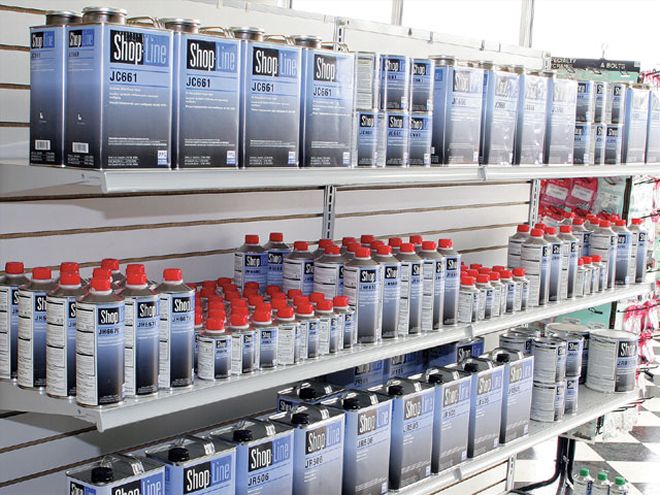 Available only through its Platinum Distributors, D&R Auto Paint and Supply in Omaha, Nebraska, reports that PPG's Shop Line is its fastest growing market. Though value-based, Shop Line products offer an economic compromise that yields a quality finish at an affordable price.
Available only through its Platinum Distributors, D&R Auto Paint and Supply in Omaha, Nebraska, reports that PPG's Shop Line is its fastest growing market. Though value-based, Shop Line products offer an economic compromise that yields a quality finish at an affordable price.
HPP: What types of products do manufacturers typically offer, and how does quality differ?
RS: All manufacturers typically offer a premium and value-based line of urethane products. Lacquer and enamel-based paints are still produced in limited quantity, but because of high Volatile Organic Compound (VOC) emissions, paint manufacturers aren't devoting further resources to these products. Both are essentially dead technology.
PPG's premium lines, Deltron and Vibrance Collection, contain a large palette of colors that feature higher resin quality, which cure quicker, and are more durable than value-line type products. They're the overwhelming choice of restoration professionals. They're also required by insurance companies since the finished repair must be in better-than-new condition when paying on a claim. Premium clear comes with a lifetime warranty against ultraviolet damage.
Though premium line sales are on the rise, our fastest growing segment is PPG's Shop Line. It's a value-based line with limited color availability and little ultraviolet screen in the clear, which means there's no manufacturer warranty. Since it costs about half as much as premium-line products, Shop Line is usually the choice of budget-minded hobbyists restoring vehicles that won't be driven much, but that they still want to look good. That doesn't suggest that Shop Line paint is low quality, however. In fact, the way paint technology works today, value-line products are better than professional-line products were as little as 10 years ago.
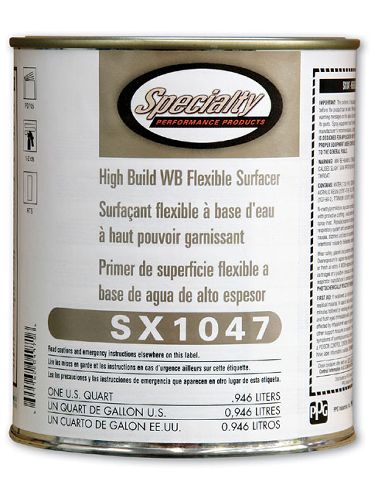 Aimed at reducing VOC emissions when applying a multi-stage finish, products like this particular surfacer in PPG's Specialty Performance Product line are no longer solvent-based, but are instead waterborne. PPG's Aquabase Plus boasts a complete line of high-quality waterborne refinishing products. California mandates the use of such products throughout much of the state, and Ron Stazzoni feels it's only a matter of time before other states follow suit.
Aimed at reducing VOC emissions when applying a multi-stage finish, products like this particular surfacer in PPG's Specialty Performance Product line are no longer solvent-based, but are instead waterborne. PPG's Aquabase Plus boasts a complete line of high-quality waterborne refinishing products. California mandates the use of such products throughout much of the state, and Ron Stazzoni feels it's only a matter of time before other states follow suit.
Clearcoat Clarification
HPP: Has clear topcoat technology changed along with basecoats?
RS: There have been some major advances in clear technology. Before, hobbyists had to wait several weeks for a vehicle's clear topcoat to cure before waxing, but cross-linking technology with basecoats has introduced clears that cure quicker, which means they can be waxed sooner. PPG has recently released a new ultra-clear product, and while it costs more than a traditional clear, it's crystal clear, and makes the basecoat look more vibrant. There's also a Soft Touch clear that gives the sensation of powder when running your fingers over it.
A new product that's being used by high-end auto manufacturers is ceramic clear. It's expensive, but very resilient to swirling and scratching. Testing has shown that after hundreds of cycles through a simulated car wash, the bristles caused typical clear to cloud, but the ceramic clear remained brilliant. It's difficult to apply, and must be smoothed within a day or two of application, but ceramic clear does offer improved finish protection.
Waterborne Wonderings
HPP: Are there any government regulations that are playing a role in current paint trends?
RS: Definitely. California is known for its stringent air-quality requirements, and in 2005 it placed strict limits on the amount of VOC that can be emitted when applying a multi-stage finish. Modern waterborne basecoats were introduced and have significantly lowered VOC emissions. Many areas in California already require its use by the end of 2008. I feel it's only a matter of time before other states follow suit. In fact, we're already seeing local collision repair shops inquiring about the conversion process.
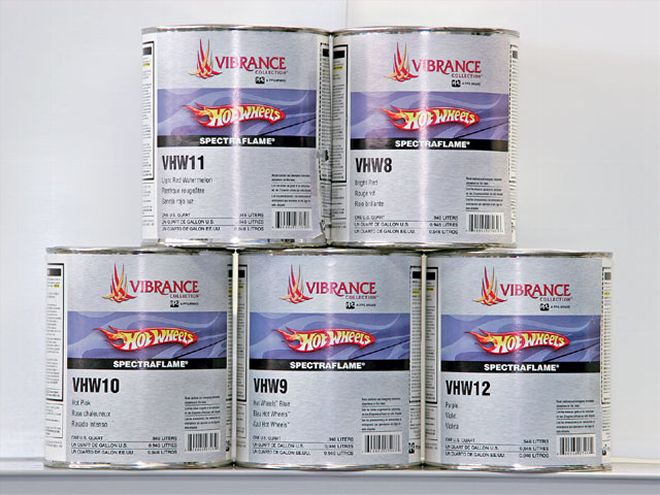 By using different pearl powders and color pigments, colors of this line can be tinted to any shade imaginable. PPG's Vibrance Collection line features an endless array of custom finishes for those hobbyists who want a uniquely colored exterior finish. As part of that same line, PPG also introduced a dozen wildly custom colors in its Hot Wheels Spectraflame series.
By using different pearl powders and color pigments, colors of this line can be tinted to any shade imaginable. PPG's Vibrance Collection line features an endless array of custom finishes for those hobbyists who want a uniquely colored exterior finish. As part of that same line, PPG also introduced a dozen wildly custom colors in its Hot Wheels Spectraflame series.
HPP: Pontiac used waterborne paints in a few of its assembly plants in the '70s and the finishes didn't age well. Should this be an area of concern for hobbyists today?
RS: No, not at all. PPG is a waterborne-paint technology pioneer, and today's product is far superior to what it was then. Waterborne paint actually contains many positive attributes when compared to solvent-based paint, but only the basecoat is presently waterborne-the primer and clearcoats remain solvent-based. Those products, too, will likely become waterborne in future years, but technology hasn't required that yet.
HPP: Can you elaborate on how waterborne basecoat differs from a similar solvent-based product?
RS: The application process of the two types is definitely different, and shops must train their technicians on the proper technique of using waterborne products. Unlike solvent-based paints that require somewhat lengthy drying times or moderate heat to bake out solvents before applying additional coats, waterborne paint requires different equipment to achieve fast flash and cure times, but it isn't as temperamental to air temperature and humidity levels within a paint booth.
Also unlike solvent-based paint, waterborne products contain nonsettling technology-the metallic stays in suspension and doesn't settle to the bottom of the container, which means that agitation isn't required when in the mixing room. Before pouring the paint into the gun, simply tilt the bottle back and forth a few times, and it's ready for use. This makes it far more favorable for color-match repairs too.
HPP: What type of unique equipment is required when applying waterborne paint?
RS: Waterborne paint requires extremely high-quality pressurized air with large-volume inline-driers. Paint guns dedicated for waterborne products are also required-water can corrode a typical gun with aluminum passages, so those designed for use with waterborne products feature plastic or stainless steel internal passages. The gun tip when using waterborne paint is also smaller.
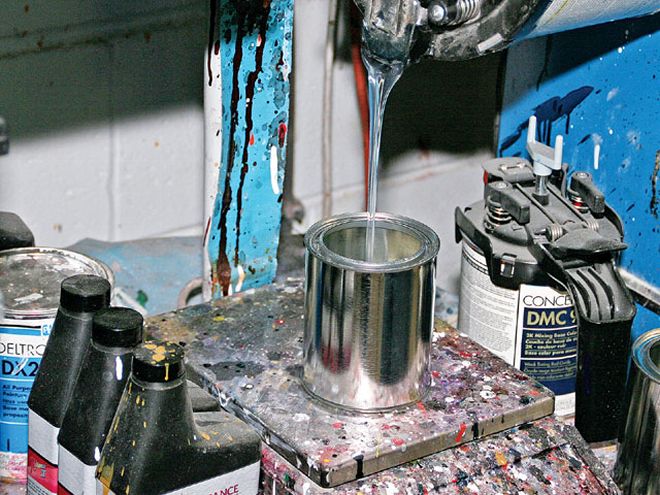 Careful attention must be paid during the mixing process to ensure that today's paint accurately matches the shade of an original color during restorations.
Careful attention must be paid during the mixing process to ensure that today's paint accurately matches the shade of an original color during restorations.
Large collision repair shops might consider investing in a high-volume air-movement system to accelerate the water evaporation process. In certain instances, a portable unit can be used, which can reduce evaporation and cure times to as little as one hour. Solvent pops are no longer an issue with waterborne products, but if the water hasn't completely evaporated before the clearcoat is applied, the finish can crack.
HPP: How is waste handled when dealing with waterborne products?
RS: Waterborne product waste is much easier to handle. Each state will likely decide upon its own forms of disposal, and right now it seems that adding coagulate is the preferred method. A coagulate is poured into the excess paint, and it separates the residual color from the water. The water is then poured off and the color sludge is left to dry. Once solid, the nontoxic color block, as well as the water, can then be disposed of in accordance to local regulation.
HPP: Is waterborne paint more costly than a similar solvent-based product?
RS: Yes, the product itself is more expensive, but the shop must invest in air-quality, specific-equipment, and employee training when applying waterborne products, and that, too, will likely reflect in the overall cost of the repair. We're finding, however, that once a facility makes the necessary changes, its employees prefer the use of waterborne paints to solvent-based products.
Conclusion
Knowing how closely related Stazzoni is with PPG Industries, we felt that he was an excellent source to address our exterior finish questions. We learned that like color trends, paint technology continually changes, and with that has come products that are vastly superior to those of just a few years back. Not only are they more environmentally friendly, today's products are also more durable and easier to handle. So the next time you begin thinking about refinishing your Pontiac's exterior, consider all the options available today. There's certainly one that will fit within your budget.
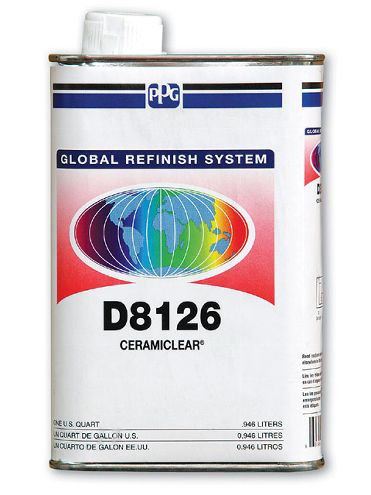 Used by high-end auto manufacturers, PPG's Ceramiclear is a ceramic-based clear topcoat that is highly scratch resistant. Though costly, it might be an option when restoring a Pontiac that will be driven regularly and can lessen the effects of routine car washes and/or polishing
Used by high-end auto manufacturers, PPG's Ceramiclear is a ceramic-based clear topcoat that is highly scratch resistant. Though costly, it might be an option when restoring a Pontiac that will be driven regularly and can lessen the effects of routine car washes and/or polishing
About D&R Paint and Supply
High Performance Pontiac: Can you briefly tell us about D&R Auto Paint and Supply and your relationship with PPG Industries?
Ron Stazzoni: My father and I established D&R Auto Paint and Supply in 1983, and we started the business from scratch. We built it on the foundation of customer service, and we continue to stand by that today. Most companies might only cater to large customers like collision repair shops, but our customer base includes local professional restoration shops and hobbyists who choose to refinish their vehicles at home.
Product quality from any of today's major paint manufacturers is excellent, and we've found PPG Industries to be a great company to work with and it really listens to its distributors. We sell PPG products exclusively and have since become a Platinum Distributor. With that comes stringent criteria we must meet to retain that status, but we're the only PPG distributor servicing the Omaha, Nebraska, metro area. I'm also a member of the PPG Counsel that meets with the company twice yearly.
Our mission at D&R Auto Paint and Supply is to combine PPG products with a high service level to offer our customers the best possible package and retain their loyalty. So far, it seems to have worked well for us.